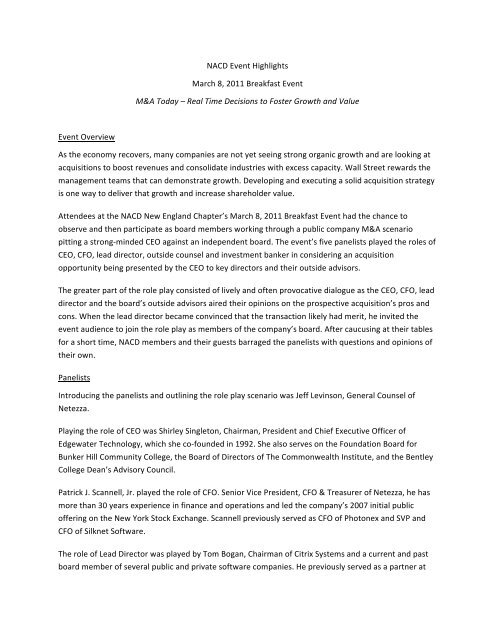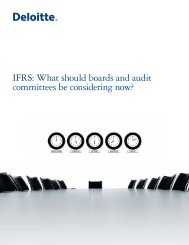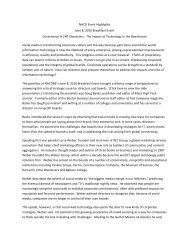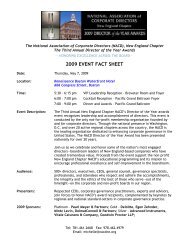NACD Event Highlights March 8, 2011 Breakfast ... - New England
NACD Event Highlights March 8, 2011 Breakfast ... - New England
NACD Event Highlights March 8, 2011 Breakfast ... - New England
You also want an ePaper? Increase the reach of your titles
YUMPU automatically turns print PDFs into web optimized ePapers that Google loves.
<strong>NACD</strong> <strong>Event</strong> <strong>Highlights</strong> <br />
<strong>March</strong> 8, <strong>2011</strong> <strong>Breakfast</strong> <strong>Event</strong> <br />
M&A Today – Real Time Decisions to Foster Growth and Value <br />
<strong>Event</strong> Overview <br />
As the economy recovers, many companies are not yet seeing strong organic growth and are looking at <br />
acquisitions to boost revenues and consolidate industries with excess capacity. Wall Street rewards the <br />
management teams that can demonstrate growth. Developing and executing a solid acquisition strategy <br />
is one way to deliver that growth and increase shareholder value. <br />
Attendees at the <strong>NACD</strong> <strong>New</strong> <strong>England</strong> Chapter’s <strong>March</strong> 8, <strong>2011</strong> <strong>Breakfast</strong> <strong>Event</strong> had the chance to <br />
observe and then participate as board members working through a public company M&A scenario <br />
pitting a strong-‐minded CEO against an independent board. The event’s five panelists played the roles of <br />
CEO, CFO, lead director, outside counsel and investment banker in considering an acquisition <br />
opportunity being presented by the CEO to key directors and their outside advisors. <br />
The greater part of the role play consisted of lively and often provocative dialogue as the CEO, CFO, lead <br />
director and the board’s outside advisors aired their opinions on the prospective acquisition’s pros and <br />
cons. When the lead director became convinced that the transaction likely had merit, he invited the <br />
event audience to join the role play as members of the company’s board. After caucusing at their tables <br />
for a short time, <strong>NACD</strong> members and their guests barraged the panelists with questions and opinions of <br />
their own. <br />
Panelists <br />
Introducing the panelists and outlining the role play scenario was Jeff Levinson, General Counsel of <br />
Netezza. <br />
Playing the role of CEO was Shirley Singleton, Chairman, President and Chief Executive Officer of <br />
Edgewater Technology, which she co-‐founded in 1992. She also serves on the Foundation Board for <br />
Bunker Hill Community College, the Board of Directors of The Commonwealth Institute, and the Bentley <br />
College Dean’s Advisory Council. <br />
Patrick J. Scannell, Jr. played the role of CFO. Senior Vice President, CFO & Treasurer of Netezza, he has <br />
more than 30 years experience in finance and operations and led the company’s 2007 initial public <br />
offering on the <strong>New</strong> York Stock Exchange. Scannell previously served as CFO of Photonex and SVP and <br />
CFO of Silknet Software. <br />
The role of Lead Director was played by Tom Bogan, Chairman of Citrix Systems and a current and past <br />
board member of several public and private software companies. He previously served as a partner at
venture firm Greylock Partners, President and COO of Rational Software until its acquisition by IBM in <br />
2003, and CEO of Avatar Technologies and Pacific Data Products. <br />
Jay Bothwick played the role of outside counsel. A partner in the Corporate Practice Group at <br />
WilmerHale, he joined the firm in 1981. He focuses his practice on mergers and acquisitions, and has <br />
significant experience in venture capital and corporate finance transactions as well. Bothwick has <br />
advised public and private companies, both domestically and overseas, in mergers and acquisitions, <br />
tender and exchange offers, proxy contests and public and private offerings. <br />
Playing the role of investment banker was Tom Cibotti, Managing Director at Covington Associates LLC, a <br />
Boston-‐based specialty investment banking firm serving the middle market sector for more than 20 <br />
years. He joined the firm in 1993 and has more than 20 years of transaction-‐related experience across <br />
many sectors. He has completed more than 60 buy-‐side and sell-‐side assignments representing more <br />
than $6 billion in transaction value. <br />
Scenario <br />
The CEO of an NYSE-‐listed technology company (the “Company”) with annual revenues of $500 million <br />
and a $1.25 billion market cap has discovered a potentially strategic acquisition target (the “Target”) she <br />
believes is undervalued. The Company has built a solid reputation on Wall Street and its hardware and <br />
software products and solutions are in a category that is evolving from “nice to have” to strategic for its <br />
customers, but demand for its products is mediocre. The CEO wants to move fast on the Target. It has <br />
interesting intellectual property and highly competitive, complementary products, while being smaller <br />
and more leveraged than the Company. The Target’s stock market performance has been choppy. <br />
Despite a thoughtful and often impassioned pitch by the CEO, both the CFO and lead director initially <br />
are not persuaded on the merits of the deal. They are concerned about the Company’s lack of a <br />
developed acquisition strategy, potential execution risks, and whether the CEO has sufficiently <br />
accounted for economic conditions or adequately considered alternative approaches, such as <br />
accelerating the Company’s organic growth. The lead director’s hesitancy also stems from the fact that <br />
the Company has only recently paid down its previously burdensome debt, coming close to violating <br />
debt covenants before doing so. <br />
The CFO and lead director’s resistance softens when the Company’s outside counsel and investment <br />
banker articulate their perspectives on the deal. The investment banker describes the current <br />
transaction environment, outlines his valuation analysis, and discusses the prospects for operational <br />
synergies and earnings accretion. The outside counsel discusses ways to structure the transaction and <br />
execute the board’s legal and fiduciary responsibilities. At that point the lead director opens the <br />
meeting to the “board members” attending the event. <br />
The Audience Weighs In <br />
2
Some of CEO Singleton’s prior comments add a confrontational flavor to this part of the role play. She is <br />
not convinced that the board really understands the business and the climate in which it operates. She <br />
implies that she has not always relied on the board’s advice in the past. She is firmly convinced that this <br />
particular deal is the only feasible path for growing the Company from $500 million to $1 billion in <br />
revenue, and seems unwilling to let the board stand in her way. <br />
When it is their turn to participate, audience members rise to the occasion with a series of thoughtful <br />
and frequently confrontational questions and comments. The first questioner challenges the CEO to <br />
explain how the deal fits into the Company’s strategic plan, knowing full well that such planning is <br />
lacking. Another asks whether the CEO is certain that it would be impossible to achieve the same <br />
transformative goals organically. <br />
Other questioners ask the CEO, CFO Scannell and lead director Bogan to explain the due diligence that <br />
has been performed on various aspects of the Target’s operations, such as products and sales contracts. <br />
They ask for an estimate of what it will it take – in terms of employment contracts – to keep the Target’s <br />
founders productively engaged over the long term, and whether an understanding has been reached <br />
with the founders as to their future roles in the combined company. <br />
The panelists are then asked whether they looked at other potential acquisition targets and, if so, to <br />
describe the evaluation process. Another “director” asks why the board was not brought into the <br />
process sooner, and another questions whether a separate board committee will be created to evaluate <br />
the deal. There are more queries related to post-‐deal integration planning, and whether the Company’s <br />
senior management team has been brought into the process at this point. <br />
Several questions are directed to investment banker Cibotti and outside counsel Bothwick, leading to a <br />
lively discussion about no-‐shop clauses and the board’s Revlon duties in a scenario such as this, as well <br />
as preparations for the inevitable lawsuits once the deal is announced. One director pointedly asks the <br />
investment banker to predict how the Company’s shareholders will react to the deal. <br />
As a follow-‐up, the panelists are asked to explain their plan for selling the strategic and financial merits <br />
of the transaction to Wall Street. They also are asked about their plan for communicating with other <br />
public audiences if the deal will result in plant closings and layoffs. The session ends with a detailed <br />
outline of next steps and overall scenario wrap-‐up by lead director Bogan. <br />
Upcoming <strong>NACD</strong>NE <strong>Breakfast</strong> <strong>Event</strong> <br />
<strong>NACD</strong> <strong>New</strong> <strong>England</strong> Chapter President Bill Earon closed the <strong>March</strong> 8 th session by reminding the audience <br />
about the Chapter’s next breakfast event: A <strong>New</strong> World of Governance for Non-‐Profit Boards. The event <br />
is scheduled for Tuesday, April 12 th at the Downtown Harvard Club, One Federal Street, Boston. <br />
3





